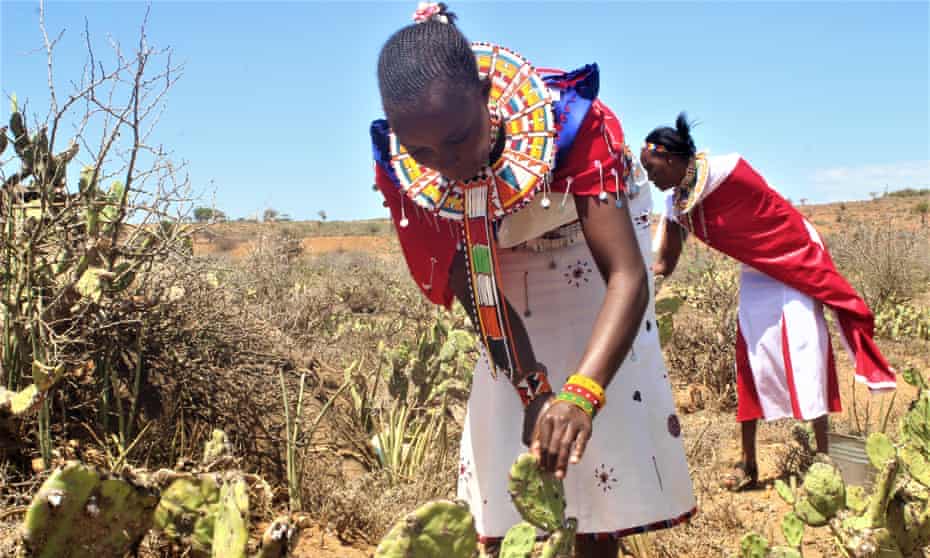 A woman removes invasive cactus plants in Laikipia County, Kenya. Photograph: Peter Muiruri
A woman removes invasive cactus plants in Laikipia County, Kenya. Photograph: Peter MuiruriImported insect offers a last hope against the invasive prickly pear cactus killing off grasslands and the animals that graze them
Global development is supported by

Peter Muiruri in Laikipia
THEGUARDIAN
Mon 6 Jun 2022
In single file, women brightly wrapped in colourful Samburu cloth come out of a small greenhouse. They carry buckets stuffed with the only weapon left in their fight against an enemy that threatens their very way of life.
They are heading to a field that despite its attractive appearance hosts the invasive Opuntia stricta, a prickly pear cactus that is taking over large swathes of northern Kenya’s rangelands, inhibiting grass growth in a landscape with poor rainfall.
In single file, women brightly wrapped in colourful Samburu cloth come out of a small greenhouse. They carry buckets stuffed with the only weapon left in their fight against an enemy that threatens their very way of life.
They are heading to a field that despite its attractive appearance hosts the invasive Opuntia stricta, a prickly pear cactus that is taking over large swathes of northern Kenya’s rangelands, inhibiting grass growth in a landscape with poor rainfall.
There will be no grass with opuntia. No grass means no livestock. With no livestock, we cannot feed our childrenPriscilla Kilua
Here in Laikipia county, some studies indicate the cactus has taken over 50-75% of communal grazing fields. It is listed among the 100 worst invasive alien species by the International Union for Conservation of Nature.
To the largely pastoralist community living within Naibunga community conservancy, the thorny plant is a deadly enemy. It lacerates the mouths of livestock and causes blindness, as its fine spines, or glochids, get lodged in animals’ eyes. The indigestible seeds also clog the animals’ intestines and, unable to feed, they become emaciated and die.
“This is our only hope,” says Florence Liosoi, a mother of five from the nearby Il Pollei group ranch as she dips her hand into a bucket of cochineal (Dactylopius opuntiae), a scale insect or “true bug” bred in greenhouses here and released to suck the sap out of the cactus and kill it.
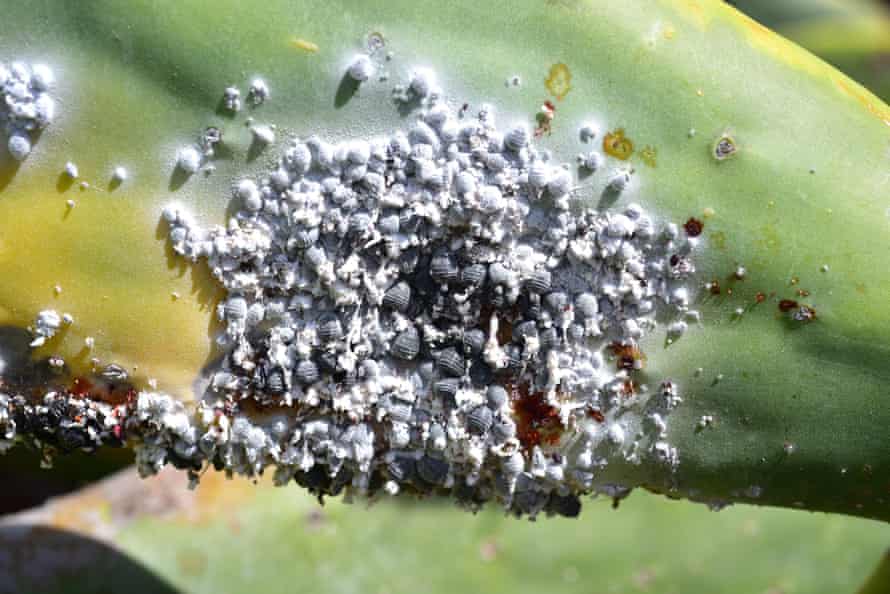
Cochineal is an hemiptera insect that which dye carmine is extracted.
Photograph: agefotostock/Alamy
The insects only eat Opuntia stricta and do not harm other forms of vegetation. The bug was imported from South Africa where it was used to control the spread of the plant in Kruger national park. In Laikipia, the bug was quarantined and trials were held in nearby Ol Jogi wildlife conservancy before it was released to the wider areas being swallowed up by the cactus.
Liosoi is among 20 women who collect cochineal-infested plants from the greenhouse and place them next to uninfected cacti in the fields. They then return to the greenhouse with fresh cacti to be covered with cochineal. It is a delicate process that leaves the women with itchy hands and legs.
The insects only eat Opuntia stricta and do not harm other forms of vegetation. The bug was imported from South Africa where it was used to control the spread of the plant in Kruger national park. In Laikipia, the bug was quarantined and trials were held in nearby Ol Jogi wildlife conservancy before it was released to the wider areas being swallowed up by the cactus.
Liosoi is among 20 women who collect cochineal-infested plants from the greenhouse and place them next to uninfected cacti in the fields. They then return to the greenhouse with fresh cacti to be covered with cochineal. It is a delicate process that leaves the women with itchy hands and legs.

NRT regional director Jacqueline Nalenoi. Photograph: Peter Muiruri
Jacqueline Nalenoi, a director with the Northern Rangelands Trust, an organisation that helps people combat the spread of the plant, says involving women in the control of the plant is crucial, since they are the ones who suffer most when fragile economies collapse due to land degradation. She says: “When livestock die, it is the women who lack the daily necessities of life such as food and proper shelter. When children get constipation as a result of eating the fruits of the cactus, it is the women who care for them. Even when there was little money to fight the invasive plant at the height of Covid-19, it was the women who volunteered to grow cochineal in the greenhouses and take it to the fields.”
Local people say the cactus was introduced here as an ornamental hedging plant by a British colonial administrator who served in nearby Dol Dol in the 1950s. Unlike indigenous plants, the cactus has no local name, so people just call it imatundai, or fruity plant in the Samburu language. “It is nutritious,” says Nalenoi. “People would eat the fruits during drought, but nobody knew how dangerous it would be to the ecosystem. It is also beautiful and made for a good potted plant. It is now threatening the existence of a whole community.”
Jacqueline Nalenoi, a director with the Northern Rangelands Trust, an organisation that helps people combat the spread of the plant, says involving women in the control of the plant is crucial, since they are the ones who suffer most when fragile economies collapse due to land degradation. She says: “When livestock die, it is the women who lack the daily necessities of life such as food and proper shelter. When children get constipation as a result of eating the fruits of the cactus, it is the women who care for them. Even when there was little money to fight the invasive plant at the height of Covid-19, it was the women who volunteered to grow cochineal in the greenhouses and take it to the fields.”
Local people say the cactus was introduced here as an ornamental hedging plant by a British colonial administrator who served in nearby Dol Dol in the 1950s. Unlike indigenous plants, the cactus has no local name, so people just call it imatundai, or fruity plant in the Samburu language. “It is nutritious,” says Nalenoi. “People would eat the fruits during drought, but nobody knew how dangerous it would be to the ecosystem. It is also beautiful and made for a good potted plant. It is now threatening the existence of a whole community.”
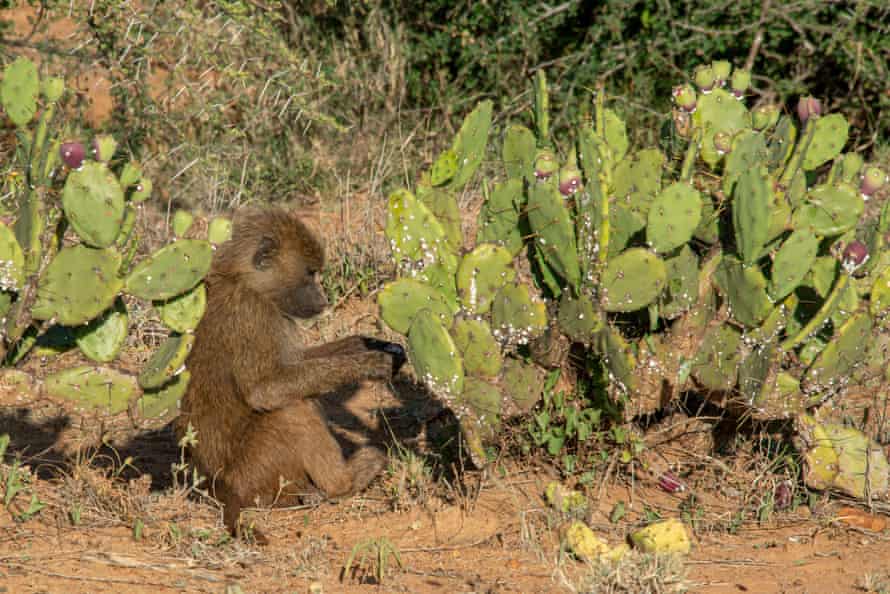
Baboons cleverly roll cactus fruits in the dirt to brush off the thorns and fine hairs that can cause infections and digestive issues.
Photograph: Gina Rodgers/Alamy
Ironically, the largely successful elephant conservation programme in Laikipia has contributed to the rapid spread of the invader. After feeding on the succulent plant with no observable harmful effects, elephants help spread the seeds through their dung to far-flung regions. “A single elephant can spread at least 2,000 seeds a day,” says Nalenoi. “In addition, small chunks of the cactus that break off the main plant can grow independently with very little water, hence the spread of the cactus in arid northern Kenya.”
Olive baboons and birds also help propagate the seeds after feeding on the plants’ reddish-purple fruits.
Ironically, the largely successful elephant conservation programme in Laikipia has contributed to the rapid spread of the invader. After feeding on the succulent plant with no observable harmful effects, elephants help spread the seeds through their dung to far-flung regions. “A single elephant can spread at least 2,000 seeds a day,” says Nalenoi. “In addition, small chunks of the cactus that break off the main plant can grow independently with very little water, hence the spread of the cactus in arid northern Kenya.”
Olive baboons and birds also help propagate the seeds after feeding on the plants’ reddish-purple fruits.
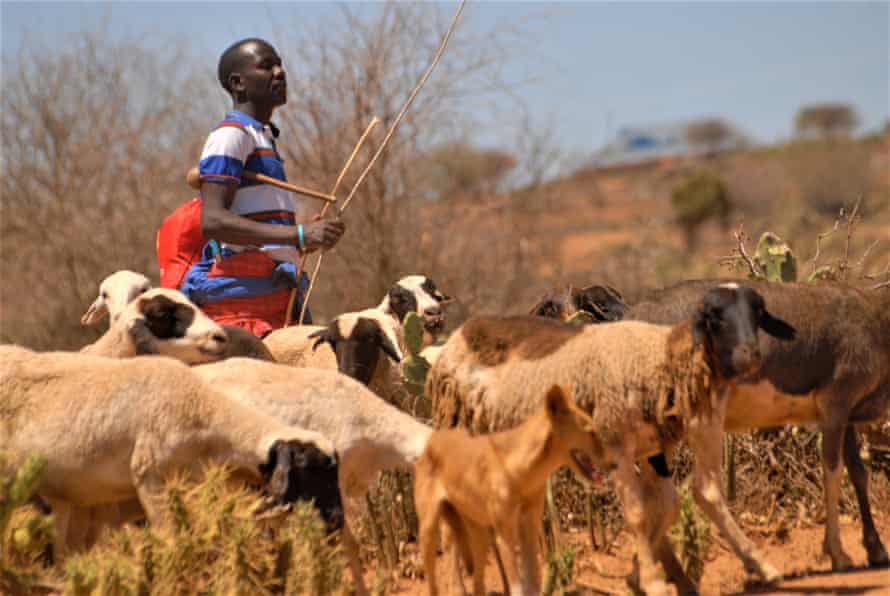
Harrison Saikong has lost over 100 sheep as a result of the animals feeding on Opuntia stricta. Photograph: Peter Muiruri
Harrison Saikong is walking his sheep along the dusty road past Munishoi village, the harsh midday sun shining down on him. It is his third day away from home, and he has walked close to 50km in search of water and pasture. In arid Laikipia, both are hard to come by and his livestock want to feed on the cactus instead.
“This plant has finished my herd,” says Saikong, 32, sheltering under an acacia tree. He lifts a sheep to show its badly lacerated and smelly mouth. “I used to have 180 sheep before many of them died after consuming this thing. I have lost 20 sheep on this journey alone. Only 40 are left.”
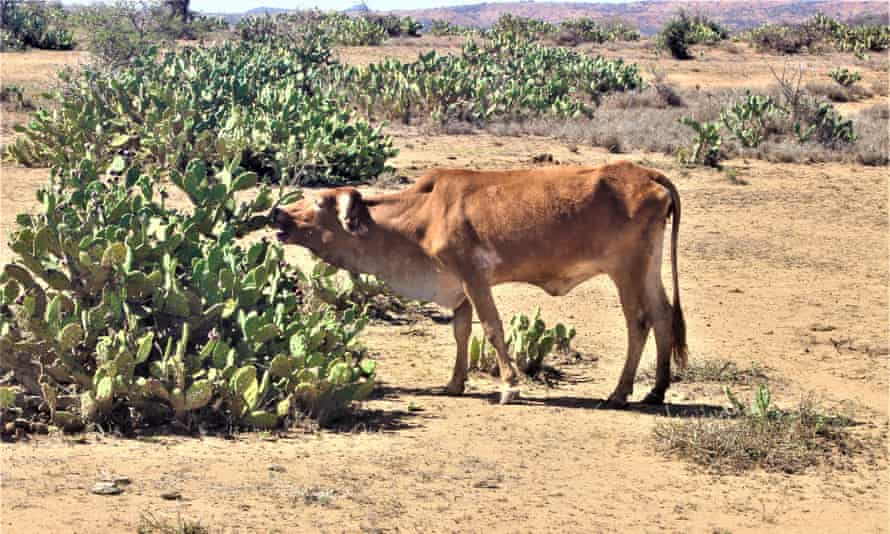
Harrison Saikong is walking his sheep along the dusty road past Munishoi village, the harsh midday sun shining down on him. It is his third day away from home, and he has walked close to 50km in search of water and pasture. In arid Laikipia, both are hard to come by and his livestock want to feed on the cactus instead.
“This plant has finished my herd,” says Saikong, 32, sheltering under an acacia tree. He lifts a sheep to show its badly lacerated and smelly mouth. “I used to have 180 sheep before many of them died after consuming this thing. I have lost 20 sheep on this journey alone. Only 40 are left.”

A cow feeds on Opuntis stricta in Naibunga conservancy. Photograph: Peter Muiruri
While elephants have accelerated the spread, unsustainable grazing practices and the climate crisis have degraded large sections of the rangelands, giving space for the cactus to take hold. In an area where livestock determines social status, it is not easy to persuade herders to offload their animals during drought and restock when conditions allow.
This becomes apparent at the home of George Sintaroi, a few kilometres down the road. His emaciated herd of cows includes some too thin to stand for long. Like Saikong, Sintaroi, 68, lost at least 20 cows through eating the plant. “I am not sure how long these ones will stay alive,” he says. “Look at this field. There is not a blade of grass, but bare earth. Opuntia is all around, and even the rains might not be of much help.” Sintaroi is trying to hold on to his remaining flock, competing for the meagre resources with wild animals, including a herd of elephants foraging near his village.
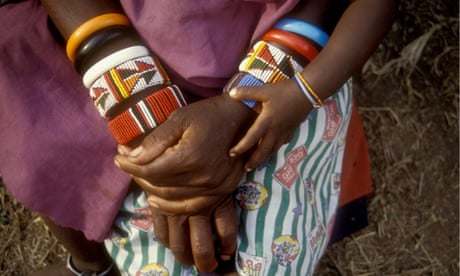
‘It’s a struggle for survival’: why Kenya – and its wildlife – need tourists to return
Sammy Leseita, director of livelihood at the Northern Rangelands Trust, says continued degradation of land will lead to unstable economies and conflict over resources. While his organisation has been helping local people mitigate the effects of climate crisis by providing watering holes, Leseita says practising sustainable livestock keeping will help stem the tide.
“Overgrazing leads to poor breeds that fetch little in the market. You have a pastoralist keeping 300 cows without enough body mass that butchers prefer. It is better to keep 20 cows that will be more profitable. Large herds only contribute to land degradation, as grass never gets a chance to produce seed since it is eaten up before reproduction,” says Leseita.
While elephants have accelerated the spread, unsustainable grazing practices and the climate crisis have degraded large sections of the rangelands, giving space for the cactus to take hold. In an area where livestock determines social status, it is not easy to persuade herders to offload their animals during drought and restock when conditions allow.
This becomes apparent at the home of George Sintaroi, a few kilometres down the road. His emaciated herd of cows includes some too thin to stand for long. Like Saikong, Sintaroi, 68, lost at least 20 cows through eating the plant. “I am not sure how long these ones will stay alive,” he says. “Look at this field. There is not a blade of grass, but bare earth. Opuntia is all around, and even the rains might not be of much help.” Sintaroi is trying to hold on to his remaining flock, competing for the meagre resources with wild animals, including a herd of elephants foraging near his village.

‘It’s a struggle for survival’: why Kenya – and its wildlife – need tourists to return
Sammy Leseita, director of livelihood at the Northern Rangelands Trust, says continued degradation of land will lead to unstable economies and conflict over resources. While his organisation has been helping local people mitigate the effects of climate crisis by providing watering holes, Leseita says practising sustainable livestock keeping will help stem the tide.
“Overgrazing leads to poor breeds that fetch little in the market. You have a pastoralist keeping 300 cows without enough body mass that butchers prefer. It is better to keep 20 cows that will be more profitable. Large herds only contribute to land degradation, as grass never gets a chance to produce seed since it is eaten up before reproduction,” says Leseita.
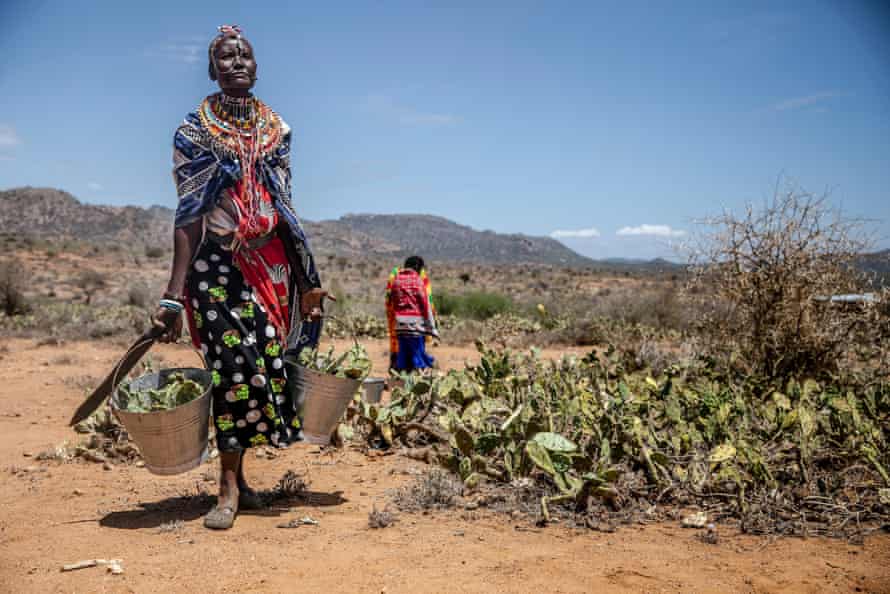
A Samburu woman removes cactus plants in Naibunga Upper Conservancy.
Photograph: Luis Tato/AFP/Getty Images
Advertisement
But people around Naibunga conservancy are at a crossroad. They need livestock to survive, but the animals fall victim to the cactus. They would like to earn money from tourism, but elephants, which are key attractions in Laikipia, are super-spreaders of Opuntia stricta seeds. “Sometimes it feels like we are just going round and round,” says Priscilla Kilua, one of the women in the team. “There will be no grass with opuntia. No grass means no livestock. With no livestock, we cannot feed and clothe our children.
“Opuntia must go. If not, then one day we shall tell our children that we used to rear goats.”
This article was amended on 6 June 2022. An earlier version incorrectly referred to cochineal as beetles; they are in fact true bugs, in the order Hemiptera and suborder Sternorrhyncha.
Advertisement
But people around Naibunga conservancy are at a crossroad. They need livestock to survive, but the animals fall victim to the cactus. They would like to earn money from tourism, but elephants, which are key attractions in Laikipia, are super-spreaders of Opuntia stricta seeds. “Sometimes it feels like we are just going round and round,” says Priscilla Kilua, one of the women in the team. “There will be no grass with opuntia. No grass means no livestock. With no livestock, we cannot feed and clothe our children.
“Opuntia must go. If not, then one day we shall tell our children that we used to rear goats.”
This article was amended on 6 June 2022. An earlier version incorrectly referred to cochineal as beetles; they are in fact true bugs, in the order Hemiptera and suborder Sternorrhyncha.
No comments:
Post a Comment